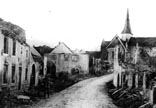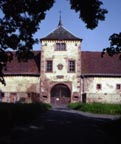 The Village of Saint Maurice lies in the Val de Ville, in the
heart of the Alsace Region, at the foot of the Vosges mountains
along the River Geisson in the Canton of Ville. The village is
approximately 15 kilometers northwest of the Town of Selestat.
The Village of Saint Maurice lies in the Val de Ville, in the
heart of the Alsace Region, at the foot of the Vosges mountains
along the River Geisson in the Canton of Ville. The village is
approximately 15 kilometers northwest of the Town of Selestat.
Located on the ancient "Salt Road" which linked the
Lorraine Salt Marshes, via the Val de Ville, to the Rhine Basin,
Saint Maurice was in its early history little more than a small
impoverished village. Originally the locality belonged to the
Benedictine Abbey of Ebersmunster near Selestat. It possessed
a chapel dedicated to Saint Maurice, a third century Roman officer
of the Theban Legion martyred in Switzerland near the Lake of
Geneva.
Saint Maurice, together with the neighboring villages of Saint
Pierre Bois and Holwarth, was later attributed to the Bishop of
Strasbourg. In 1464 Saint Maurice was sufficiently important
to become a rectorate. In 1490 the village was sold to the Grand
Chapter of the Cathedral of Strasbourg which owned the neighboring
estate of Frankenbourg. Following the Thirty Years War in 1632
the parish became a subsidiary of the rectorate of Neuve Eglise.
Saint Maurice again became an independent parish in 1843 and
the older Dontenville children were baptized there.
 In the early days, the "Salt Road" was often used by
passing armies and as a result Saint Maurice was a troubled and
impoverished village. The people made their living from agriculture,
wine growing, and domestic weaving. Between 1800 and 1866 the
population of the Canton of Ville, in which Saint Maurice is
located, grew from 10,000 to over 14,000.
In the early days, the "Salt Road" was often used by
passing armies and as a result Saint Maurice was a troubled and
impoverished village. The people made their living from agriculture,
wine growing, and domestic weaving. Between 1800 and 1866 the
population of the Canton of Ville, in which Saint Maurice is
located, grew from 10,000 to over 14,000.
The Val de Ville was unable to support the overpopulation. The
loss of earning, lack of prospects for the young, and a cholera
epidemic in 1849 resulted in the emigration of the Ludwig Dontenville
family and many other inhabitants of the valley to the United
States in the 1850s.. Refusal to accept Prussian occupation
after 1870 resulted in the eventual emigration of Wallace and
Emile Dontenville to the United States in the early 1880s.
During the early Stages of the Second World War the village was
devastated by an assault of German soldiers encamped in the valley.
On the afternoon of August 17, 1914, a French Cavalry patrol
approached the vicinity of Saint Maurice. Three riders entered
the village. Bavarian infantry men who were also circling the
upper part of the village engaged the French and several shots
were fired.
 That night a group of French infantry occupied the railway station
in Saint Maurice. The citizens of the area sought refuge in their
cellars. A number of shots were fired in pitch darkness, from
houses in the center of the city. The order was given to set fire
to all houses in the center as well as along the main street.
In total 38 buildings, were destroyed and four civilians and
two French soldiers were shot. Alphonse Dontenville was among
the citizens of Saint Maurice who were killed that night. The
parish church was burned and most of the vital records were destroyed.
That night a group of French infantry occupied the railway station
in Saint Maurice. The citizens of the area sought refuge in their
cellars. A number of shots were fired in pitch darkness, from
houses in the center of the city. The order was given to set fire
to all houses in the center as well as along the main street.
In total 38 buildings, were destroyed and four civilians and
two French soldiers were shot. Alphonse Dontenville was among
the citizens of Saint Maurice who were killed that night. The
parish church was burned and most of the vital records were destroyed.
 Chateau de Thanville, located a brief walk east of Saint Maurice,stands
as an impressive example symbol of the aristocracy that once controlled
the Val de Ville. Constructed in 1650 by Frederic de Tanviller,
the Chateau was pillaged by German soldiers during the Franco-
Prussian War in retaliation for an attack on them by the villagers
and was used as a military hospital during World War I. The Chateau
was sold to an industrialist family in 1981 and stands today in
a state of disrepair.
Chateau de Thanville, located a brief walk east of Saint Maurice,stands
as an impressive example symbol of the aristocracy that once controlled
the Val de Ville. Constructed in 1650 by Frederic de Tanviller,
the Chateau was pillaged by German soldiers during the Franco-
Prussian War in retaliation for an attack on them by the villagers
and was used as a military hospital during World War I. The Chateau
was sold to an industrialist family in 1981 and stands today in
a state of disrepair.
Between the two World Wars, the village flourished. Horse drawn
vehicles gave way to the small trains running between Selestat
and Ville. The inhabitants found work in factories in the valley.
The Second World War brought return of the Armies of Germany.
The village itself suffered little more than a bad fright but
compulsory enlistment in the
Wehrmacht,
general shortages, the
concentration camps and humiliations were a bitter trial for all.
The American 103rd Division liberated the area on November 29,
1944.
In the years since the Second World War, Saint Maurice has continued to be one of the beautiful villages of the Val de Ville. Despite its strategic location, it never grew appreciably in population. The village reached its peak at 466 in 1846, just before the first Dontenville's departed for the United States. Today the population stands at about 400.
Farming is no longer the main endeavor. Today most of the residents work in offices and factories in the nearby cities of Selestat and Colmar or in businesses related to the wine industry. Saint Maurice is not a major wine producer. In recent years many small chalet-type homes have been built in the region as people from Paris, Switzerland, and other countries find the Val de Ville a serene and attractive place in which to spend their vacations.